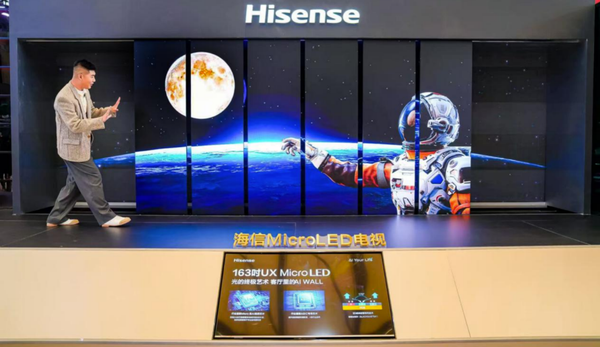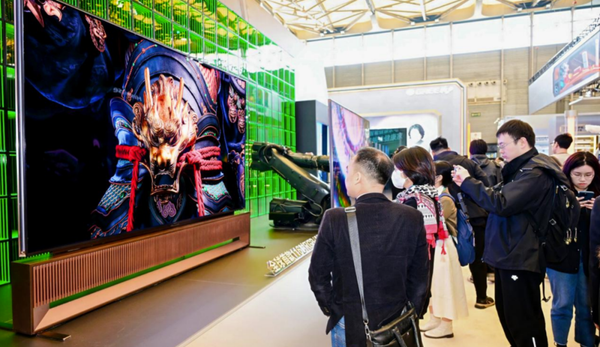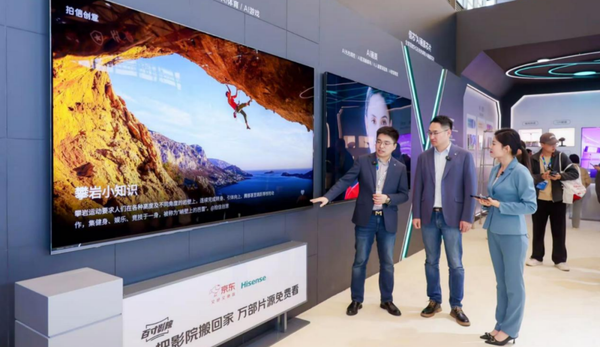AWE Observation: Your Next TV is an AI WALL
Today at AWE (2025), Hisense showcased a product matrix of over 30 models, including the world's largest 116-inch RGB-Mini LED TV, completely overturning the traditional logic of TV selection.
AWE, as one of the world's top three home appliance and consumer electronics exhibitions, gathers the most cutting-edge technology products and innovative concepts from around the globe. In the television sector, Hisense, as a global leading brand, makes its presence felt at home. This AWE, it brings the world's first 116-inch RGB-Mini LED TV, the UX, along with its full lineup of 100-inch products, marking the dawn of the living room WALL era. It shifts the consumer selection logic from "choosing size based on viewing distance" to "selecting TV based on wall area," achieving another leap in large-screen TVs.

TV iteration the larger the better looking
Coming to the Hisense booth area, the most intuitive feeling is that all the large-size TVs here are "WALL"! The 116-inch UX, the 120-inch laser flagship new product "Exploration X1", and the 136-inch and 163-inch Micro LED TVs, these over 100-inch large screens seem like on-site "big stars", attracting countless people to watch and check-in. Especially the Micro LED TV, the staff said it also supports free splicing, with a maximum customization up to 271 inches.
Perhaps only by being on-site can one deeply appreciate how stunning the Hisense living room WALL era truly is. This also makes家电魂感慨, the logic of choosing a TV might really have to change. In the past, everyone chose the TV size based on the distance from the living room sofa to the TV wall. Even for large households, many people were still hesitant to easily buy a 100-inch TV. Because that would be limited by technology and materials, larger screens meant lower picture quality, and watching too close resulted in a mosaic-like image quality, affecting the viewing experience. Note: "家电魂" does not have a direct English translation as it appears to be a specific term or name, so it was left untranslated. If you need a specific translation or interpretation for "家电魂," please provide additional context.
And this time in the Hisense exhibition hall, these screens over a hundred inches are extremely clear, not only with vibrant colors and delicate images, but also dynamic and vivid, with soft contrast, and a very strong sense of picture quality, providing a deeper immersive experience. They are pleasing to the eye and offer a very comfortable viewing experience. Even when viewed up close, there is no glaring or dizzy feeling.

Tricolor display initially takes shape, both audio and visual experiences are upgraded
Ultra-large TVs over a hundred inches can also have good picture quality, thanks to the upgrade of Hisense's picture quality technology. In particular, the RGB three-dimensional color control technology has achieved a significant leap from single light control to simultaneous light and color control, and it has already been mass-produced.
So what is the difference between RGB-Mini LED TV and traditional Mini LED TV? According to the on-site staff, Hisense RGB-Mini LED TV, unlike traditional Mini LED TVs with single-color backlight, adopts RGB red, green, and blue primary color backlight sources. Under the precise control of the Xin Chip AI picture quality chip and the RGB-MiniLED backlight chip for light color synchronization, its light source color control accuracy can reach more than three times that of traditional LCD TVs. While reducing energy consumption, it brings higher picture contrast and color accuracy, making the color experience more vivid.
In addition to the RGB-MiniLED TV, Hisense showcased the world's first self-luminous Micro LED TV at this exhibition, which features 24.88 million Micro LED chips and provides a 48nit viewing mode, precisely matching the DCI cinema standard, bringing a high-end home theater visual experience; the new laser flagship model X1 Explorer adopts the "DLP digital cinema projection technology" of the same origin as movie theaters, boasting the industry's highest 110% BT.2020 cinematic color gamut, and is also equipped with Hisense's pioneering spectral selection screen, increasing brightness to 1000nit, greatly enhancing the viewing experience on large screens. Currently, Hisense's tri-color display technology has been fully implemented in LCD, laser TVs, and projection products, with tri-color display technology initially taking shape and occupying a technological high ground.

Not only has new technology been implemented, but the existing audio and video technologies have also been upgraded. For example, Hisense launched a new generation of AI picture quality chip—the Xin Chip AI Picture Quality Chip H7, which can control light and color simultaneously, automatically optimize details, and improve 2K to 4K picture quality for clearer images; the 100-inch family, including the 100UX, 100E8Q, E8Q Pro, 100E7NPro, and 100U7Q, have all been comprehensively upgraded to Obsidian Screen Ultra, featuring 4 times the black level, ultra-high contrast, super three-dimensional images, and a 178° wide viewing angle for clear visibility from any angle.
And to adapt to the top-tier picture quality, the RGB-Mini LED TV also features the world's top luxury audio system — Devialet, fully incorporating Devialet's core algorithms, technology, and tuning, providing an immersive sound experience that is unparalleled.
Home Appliance Soul believes that it is precisely because of holding these advanced picture quality technologies that Hisense dares to propose "selecting TVs based on the TV wall area."
Because of these technological breakthroughs, it is enough to overturn the stereotype that "large screens have poor picture quality." After experiencing it firsthand, users will no longer have doubts when making a purchase. It is believed that under the leadership of Hisense, the concept of buying larger rather than smaller TVs will gradually become the public's perception.
AI is everywhere TV understands you better
In the era of continuous technological advancement, the integration of electronics with AI has become a market consensus, and televisions are no exception. In this Hisense exhibition area, one can also feel that, as a leader in AI TVs, Hisense has achieved a comprehensive integration and deep application of AI with televisions. Products such as the newly released RGB-MiniLED, laser TVs, smart projectors, and Big White Companion machines have all been connected to the latest AI intelligence, capable of automatically triggering matching intelligent services based on the user's actual usage scenarios and intentions, turning the TV into your family tutor, fitness coach, travel guide, and more, achieving barrier-free communication and service.
For example, you can chat with the TV like an old friend, and no matter what you want to do or what questions you have, you can find the corresponding intelligent agent to ask and resolve your doubts at any time. With 24 dialect recognition functions, it achieves barrier-free communication for any question, in any scenario, and with any object.

Finally,家电魂believes that with the development of AI technology and the continuous innovation of display technology, the living room of the future will evolve into a highly intelligent, emotional, and scenario-based core living area. The TV will become a home hub with proactive thinking capabilities. After the TV is equipped with AI thinking capabilities, it will not only bring an improvement in technical parameters but also an evolution in family lifestyle, marking a leap from "tool" to "butler." Through proactive sensing, scene linkage, and form innovation, the TV becomes the "smart brain" of the home, redefining the relationship between people and space, as well as devices and content.
【Copyright and Disclaimer】The above information is collected and organized by PlastMatch. The copyright belongs to the original author. This article is reprinted for the purpose of providing more information, and it does not imply that PlastMatch endorses the views expressed in the article or guarantees its accuracy. If there are any errors in the source attribution or if your legitimate rights have been infringed, please contact us, and we will promptly correct or remove the content. If other media, websites, or individuals use the aforementioned content, they must clearly indicate the original source and origin of the work and assume legal responsibility on their own.
Most Popular
-

U.S. Appeals Court Officially Rules: Trump Tariff Unlawful and Void!
-

[Today's Plastics Market] General Materials Weakly Fluctuate, Engineering Materials Steadily Rise
-

At Least 44 Dead in Century-Old Fire! Questioning Hong Kong's Hong Fu Garden: Why Has the Path to Fire Resistance Taken 15 Years Without Progress?
-

Avatr Files for IPO on HKEX, Plans to Complete Listing in Q2 2026
-

Satellite chemical's profits surge! can the 26.6 billion yuan high-end new materials project meet expectations? a review of progress on four major projects






